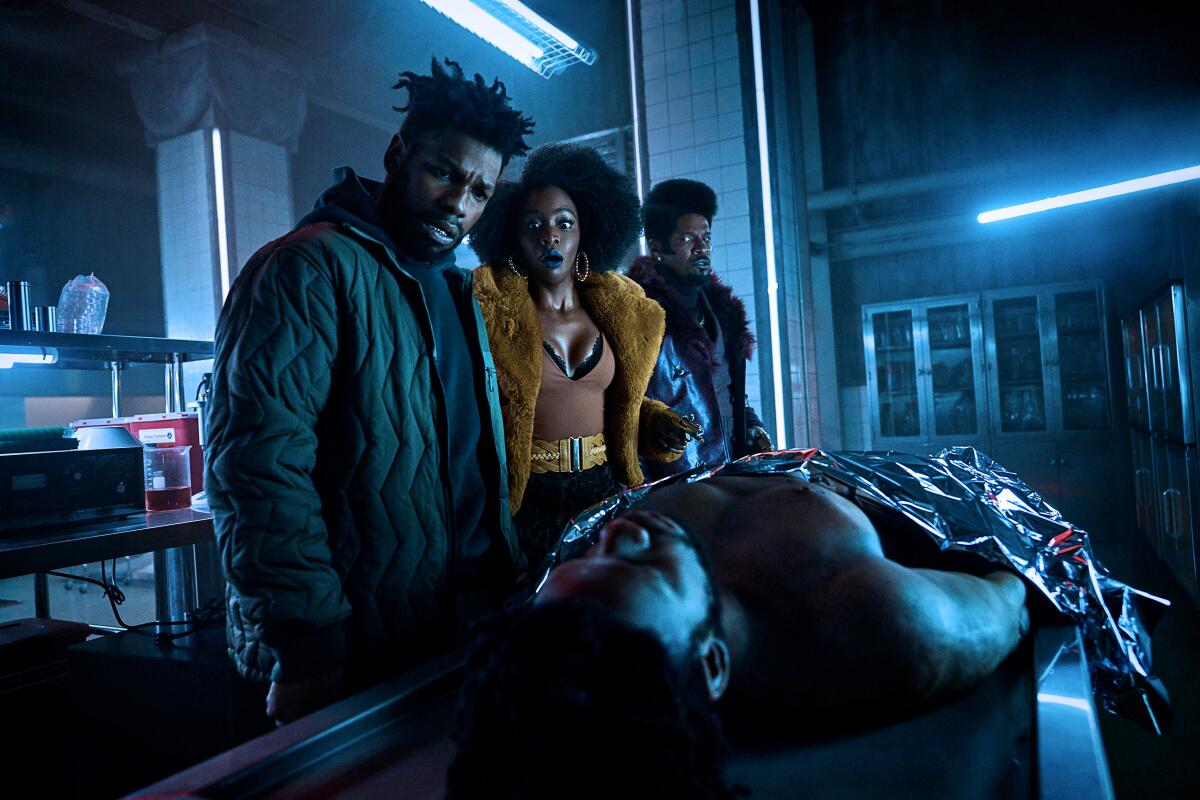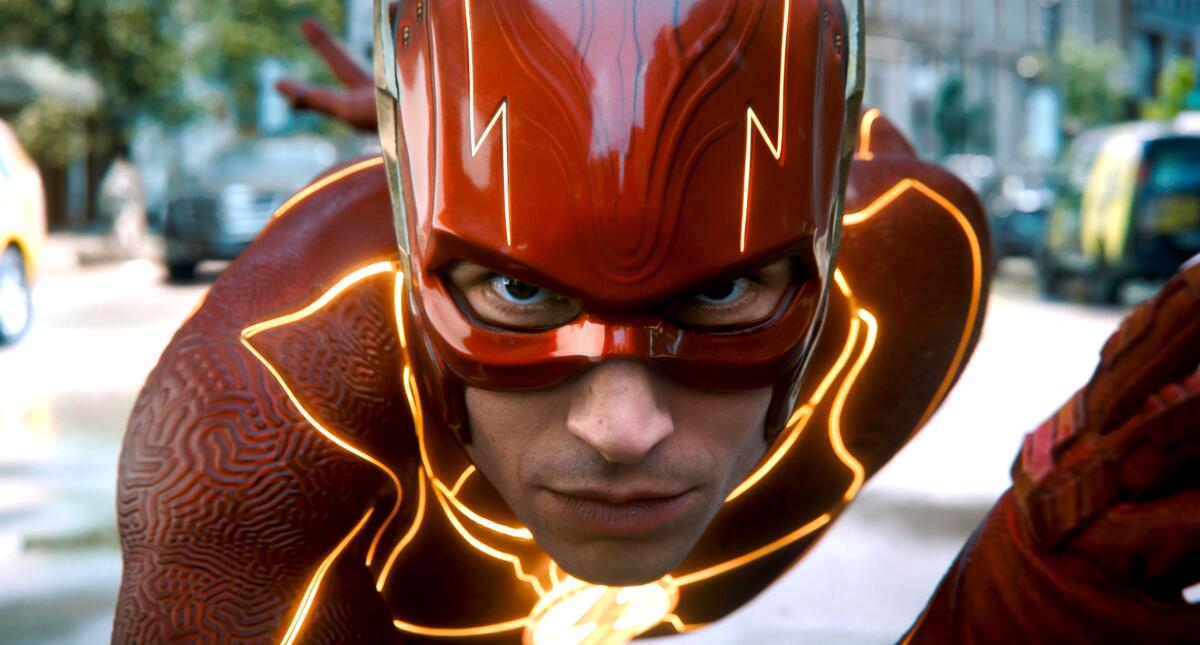Propulsive and risky, ‘They Cloned Tyrone’ is just what you want from young filmmakers

- Share via
‘They Cloned Tyrone’
The offbeat science-fiction comedy “They Cloned Tyrone” has a high-concept premise, delivered with a distinctively skewed, slapstick-esque comic rhythm. The movie’s big idea: What if a shadowy government cabal had a secret lair located just below a predominantly Black neighborhood known as the Glen. And what if they were conducting experiments in mind control using junk food, hair products and club jams? And what if a gang boss, a pimp and a prostitute stumbled on the conspiracy and tried to expose it, in their own clumsy, bickering way?
These three unlikely heroes are, respectively, Fontaine (John Boyega), Slick Charles (Jamie Foxx) and Yo-Yo (Teyonah Parris). Writer-director Juel Taylor and his co-writer Tony Rettenmaier spend a long time at the start of the movie establishing the trio’s daily life in the Glen, where nearly everybody’s hustling, trying to get what they’re owed from people who are broke. “They Cloned Tyrone” has a grainy look and a retro soundtrack, akin to a ‘70s blaxploitation picture. Taylor and Rettenmaier are evoking “Superfly” — along with “They Live” and a bit of “O Brother, Where Art Thou?”
The latter two influences kick in after Fontaine gets assassinated by one of his rivals and then — surprising everyone who saw him die — shows up the next day around the Glen as usual, with no memory of what happened. The Nancy Drew-obsessed Yo-Yo springs into action, leading Fontaine and Slick Charles on an investigation into the resurrection that ends up unraveling multiple mysteries in their community. In the opening scenes of “They Cloned Tyrone,” the constant banter among this trio has a hostile, almost shrill edge. When they start working together, they’re more like three lovably goofy detectives.
Some viewers may still, understandably, find this movie’s humor elusive. The story takes a while to get going, then rambles a lot once the premise has been established. And the dialogue zooms along so fast that it can be hard to follow. But young filmmakers are supposed to take chances like this. They should be so full of things to say, so jazzed about their own creativity, that they overindulge. In a way, that ends up being the message of this film. Taking risks — even when they court disaster — is always better than settling for the same-old same-old.
“They Cloned Tyrone.” Rated R for pervasive language, violence, some sexual material and drug use. 2 hours, 2 minutes. Available on Netflix
‘Stephen Curry: Underrated’
The title of Peter Nicks’ documentary “Stephen Curry: Underrated” is provocative, given that Curry is a two-time NBA MVP with four championship rings. But the film’s opening scene sets the tone, with Reggie Miller — the man once considered to be the NBA’s three-point-shooting master, pre-Curry — reading off Curry’s NBA draft report, in which scouts said he was too small and frail to make much of an impact as a pro. Nicks builds from there, telling the story of a basketball player who in some ways had every advantage — he’s the son of the NBA journeyman Del Curry — yet flew under the radar as a high school recruit before leading tiny Davidson College to a memorable 2008 NCAA Tournament run.
“Underrated” alternates scenes from Curry’s rise to to national prominence at Davidson with scenes from 2022, when he was simultaneously trying to rebound from injuries, lead his Golden State Warriors back to the playoffs, and fulfill a promise to his mother to complete his college degree. The structural model for this film seems to be the Michael Jordan docuseries “The Last Dance,” combining a lot of rare old footage with fresh reflections. But Curry doesn’t have Jordan’s thorny personality. As much as Nicks tries to sell him as an underdog, the story here is mostly of a talented, dedicated, kindhearted man who is both wildly successful and widely admired.
Yet even if the narrative feels a little forced, the movie still works. There’s a reason why Curry has been a superstar since he was a teenager: He’s an electric player who generates highlight-reel material nearly every time he steps on the court. “Underrated” doesn’t offer any groundbreaking insight into Curry as a person or an athlete. But it is a good reminder of just how long he’s been amazing.
‘“Sephen Curry: Underrated.” Rated PG-13 for brief strong language. 1 hour, 50 minutes. Available July 21 on Apple TV+
‘The Deepest Breath’

Competitive free-diving is a sport with many different disciplines, but in the documentary “The Deepest Breath” the one we see most often involves divers descending as far as they can with no oxygen tanks. Director Laura McGann assembles some nerve-wracking video (enhanced by a few seamlessly integrated reenactments) of the record-breaking Italian diver Alessia Zecchini holding her breath for minutes to reach targets more than 100 meters deep. According to the film, early in her career Zecchini sometimes showed more stubborn determination than responsible technique. But with the help of the skilled Irish safety diver Stephen Keenan, she surprised her peers with how much she accomplished, so young.
McGann intertwines the stories of both Zecchini and Keenan — the latter of whom led a restless nomadic life before becoming a trusted mentor within the free-diving community — via interviews with friends and colleagues. The interviewees mostly talk about Zecchini and Keenan in the past tense, suggesting something terrible happened to them; and indeed, “The Deepest Breath” builds to a tragic accident that leaves one person dead. Frankly, it might have been better for the film to reveal this outcome at the start, sparing viewers who know nothing about free-diving the distractingly ominous foreboding.
Despite the morbid preoccupation with diving’s dangers, “The Deepest Breath” is an intense and often beautiful movie, likely to appeal to fans of extreme sports documentaries like “Free Solo” and “Riding Giants.” People like Zecchini and Keenan don’t just test the limits of human endurance, they explore parts of our planet that most people never see, without the buffers of vehicles or heavy gear. Through films like this, we get to experience a little bit of what they do — and to understand why.
“The Deepest Breath.” Rated PG for some intense peril, unsettling images and language. 1 hour, 48 minutes. Now available on Netflix.
‘Fear the Night’
The veteran writer-director Neil LaBute has, throughout his career, bounced between raw genre exercises and dialogue-driven dramas, often tackling hot-button social issues. And occasionally he’s tried to combine the two, as he does with mixed success in his new home invasion thriller “Fear the Night.”
Maggie Q plays Tess, a moody military veteran who reluctantly joins her judgmental sister Beth (Kat Foster) for a bachelorette party weekend at their parents’ vacation home. When the women are attacked by local drug dealers — who’ve been using the property as a stash house — Tess draws on her training to fight back, becoming the most essential person to a group of friends who previously considered Tess to be kind of a drip.
LaBute delivers a serviceable suspense movie, filled with tense scenes of the trapped women making daring escape plans that don’t always work out. The bad guys here — and they are all guys, because this is a Neil LaBute film — are armed with bows and arrows, which makes their bursts of violence all the more surprising and wince-inducing.
The biggest shock in “Fear the Night” though is how flat its dialogue is. LaBute draws some human drama out of Tess’ unwillingness to be “just one of the gals,” and there are a few fun scenes where she challenges macho misperceptions about what she can and can’t do. But for the most part, “Fear the Night” feels like it could have been made by almost anybody. It’s crafty enough, but it’s lacking LaBute’s usual acid wit and fearless provocations.
‘Fear the Night.’ Not rated. 1 hour, 32 minutes. Available on VOD.
‘Hidden Blade’
Writer-director Cheng Er jumps back and forth in time between the late 1930s and the first half of the 1940s for the slick spy thriller “Hidden Blade,” a film about double agents in Shanghai working with the nascent Chinese Communist Party to undermine the Japanese occupation before and after the attack on Pearl Harbor. Tony Leung plays Director He, who along with his wife (Zhou Xun) poses as a loyalist to the occupiers while feeding information to the underground.
Cheng stages a few exciting and stylish fights, shootouts and chases; and the jumbled timeline challenges the audience to discern who’s a real true believer and who’s taking sides for pragmatic reasons. For the most part though, this movie is pretty static, consisting of men and women in fashionable clothes speaking quietly in strikingly lighted rooms. Since nearly every conversation is plot-driven, the characters don’t really develop complex personalities.
“Hidden Blade” is also light on moral ambiguity, because it’s meant to be a celebration of courage, and not a nuanced study of the costs of waging war. The bluntness keeps the film from approaching greatness, although history buffs and genre fans might appreciate a World War II story told from a unique, non-Western perspective.
“Hidden Blade.’”In Mandarin with subtitles. Not rated. 2 hours, 8 minutes. Available on VOD.
‘Mother, May I?’
Early in the psychodrama “Mother, May I?,” the young couple Emmett (Kyle Gallner) and Anya (Holland Roden) do a therapy exercise. Emmett’s mother — who abandoned him when he was a child — has unexpectedly left him her estate, including a huge country house. He seems indifferent to the gift, so Anya tries a role-playing exercise where she pretends to be him, to get to the bottom of how he’s really feeling. When that doesn’t work, Emmett and Anya do mushrooms together while she playacts as his mom. Then she just stays in character, for days — until he starts wondering if she’s been possessed.
Written and directed by Laurence Vannicelli, “Mother, May I?” has elements of gothic horror sprinkled into a picture that at heart feels more like an ennui-laden old European art film. The house is a striking-looking location — alternately warmly homey and forbiddingly austere, depending on what’s happening in the story — and Gallner and Roden fill those spaces with finely shaded performances, blending panicked anxiety and dark humor.
The movie’s “mommy issues” motif never cuts as deeply as it could — although there are some squirmy scenes where Emmett isn’t sure how to handle being sexually attracted to a woman who’s channeling his mom’s spirit. But as an exhibition of visual style and acting prowess, “Mother, May I?” is impressive. It’s a handsome-looking ghost story, about a man who was haunted by his mother even when she alive.
“Mother, May I?” Not rated. 1 hour, 39 minutes. Available on VOD.
Also on VOD

‘The Flash’ didn’t exactly light up the box office during its theatrical release, but it might pick up some admirers now that it’s on home video, given how tailored the film is to devoted fans of the DC Comics cinematic universe. A spinoff of “Justice League,” the movie stars Ezra Miller as a super-speedy, socially awkward hero who joins forces with colleagues across multiple universes — and multiple films and TV series, some from decades ago — to try to undo damage wrought when his trip into the past inadvertently changes the timeline. Available on VOD.
Available now on DVD and Blu-ray
‘The Ranown Westerns’ collects five of the seven movies that director Budd Boetticher made with actor Randolph Scott in the late 1950s: simply plotted, tightly constructed films regarded by many as among the best of the Hollywood western’s most creatively fertile era. The box set adds a combination of new and old special features, including commentary tracks, interviews, video essays and admiring introductions from esteemed critics and filmmakers. The Criterion Collection
More to Read
Only good movies
Get the Indie Focus newsletter, Mark Olsen's weekly guide to the world of cinema.
You may occasionally receive promotional content from the Los Angeles Times.







